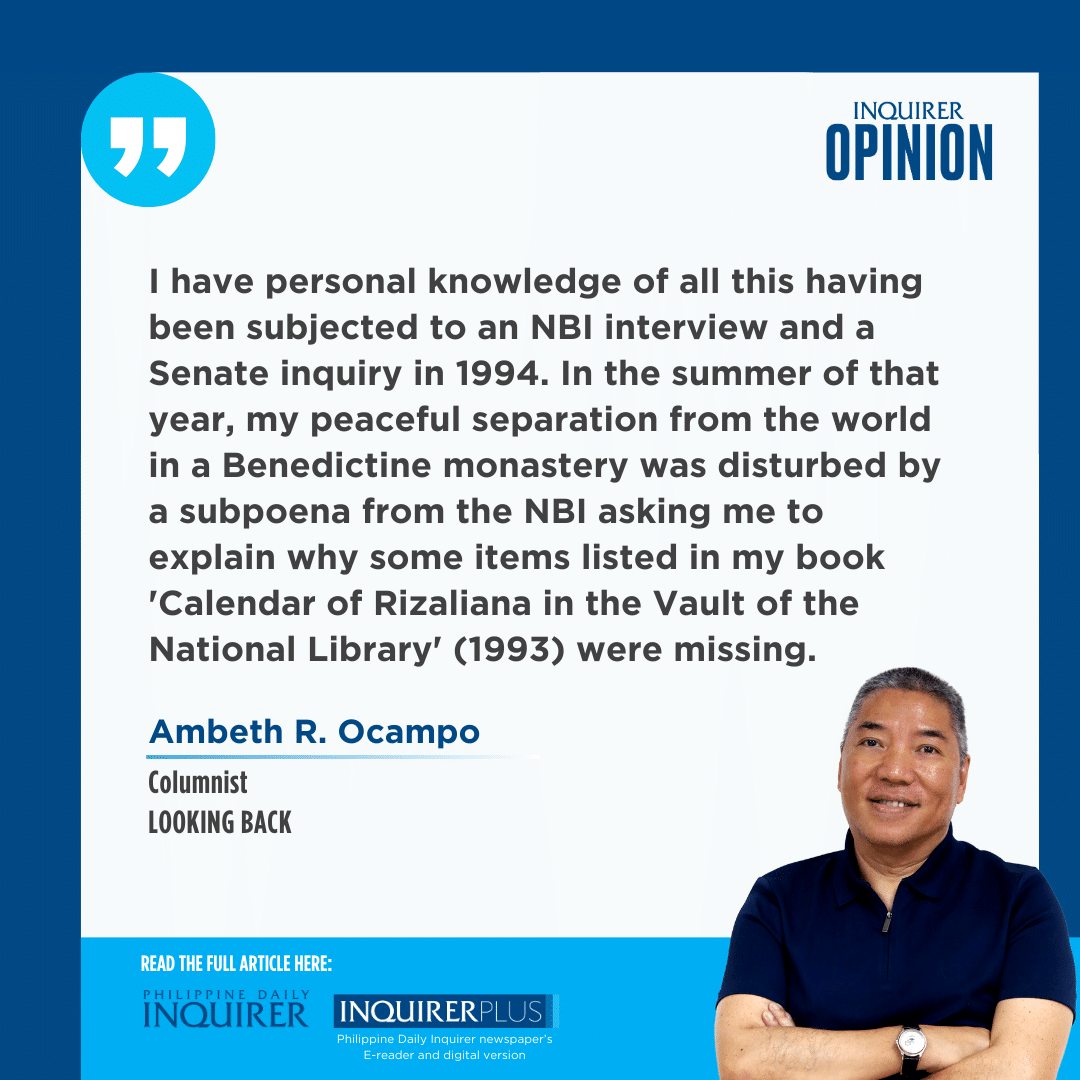Our stolen heritage
The recovery from eBay of a historical document stolen from the National Library of the Philippines is cause for rejoicing. We should not, however, stop there and find out who consigned the stolen document, and ask this person where it came from and when it came into his or her possession.
The sale was brazen (or ignorant) because the document carried stamped property marks from the “Philippine Insurgent Records.” These documents, seized by the enemy during the Philippine-American War, were shipped to the United States and cataloged by Capt. J.R.M. Taylor, who compiled a five-volume selection of important documents that was suppressed by William Howard Taft and only saw publication by the Lopez Museum under Renato Constantino in 1971.
Article continues after this advertisementThe US National Archives returned the physical documents to the Philippines after World War II. This is a fine case to prove that repatriation of our heritage does not always work out well. Before the documents were shipped to Manila, everything was preserved in microfilm by the US National Archives so any historian wishing to use the “PIR” is better off using the US microfilm that is complete and indexed.
The physical documents in Manila were renamed into the “Philippine Revolutionary Records” and refiled after the Ruby Towers earthquake scattered boxes and documents on the floor of the library. Other documents deteriorated because of the high humidity in Manila, others were lost or stolen over the years until a full investigation was prompted by the arrest of a researcher from the National Historical Institute who was caught by the National Bureau of Investigation (NBI) agents selling pilfered documents to an antique dealer a few blocks away from the Library.
I have personal knowledge of all this having been subjected to an NBI interview and a Senate inquiry in 1994. In the summer of that year, my peaceful separation from the world in a Benedictine monastery was disturbed by a subpoena from the NBI asking me to explain why some items listed in my book “A Calendar of Rizaliana in the Vault of the Philippine National Library” (1993) were missing. In an affidavit to the NBI, a Senate hearing, and press interviews, the acting National Library director repeatedly (and I should add libelously) stated that I was the last person to handle the missing Rizal manuscripts implying that I stole them.
Article continues after this advertisementWhat was conveniently, and I should add, maliciously left out of her narrative was the reason for my access to the Rizaliana collection. No mention or acknowledgment was made of my published “Calendar,” without which the Library would not even know what pieces of Rizaliana were missing. All this posturing was “pusit” or a smokescreen to obscure the glaring incompetence of the Library. As a matter of fact, in a long letter signed by the Filipiniana and Asia Division staff at the time, they objected to sharp observations I had made regarding library service in the preface of the “Calendar.” They demanded both a retraction and a public apology.
A thorough NBI investigation revealed that an inventory report on the Rizal material was submitted in June 1993. Nothing was declared missing, until the publication of my “Calendar” in August 1993. In a private memo to the Library director, the staff admitted: “That comparing the [Library] inventory list with that of Ambeth Ocampo’s ‘A Calendar of Rizaliana in the Vault of the Philippine National Library,’ we noticed many items found in his bibliography not listed in the inventory list …” Not only was the Library inventory incomplete, some of the manuscripts had no property marks. This begs the question, why would I list items, make them public, and steal them?
All this was not new, in 1961 the original manuscripts of Rizal’s “Noli me tangere,” “El Filibusterismo,” and “Mi último adiós” were stolen and held for ransom. These were recovered by then Education Secretary Alejandro Roces and one person went to jail for it. Since the rescue of these treasures, everything was kept from public view by keeping the material locked in a vault whose combination and keys were known to only one person, the chief of the Filipiniana Division. The standard excuse for scholars who needed access to the originals in the vault was that all these had been previously published, many in offset reproduction, by the Jose Rizal National Centennial Commission in 1961. But when I went through the manuscripts, I recovered a 245-page draft of Rizal’s third novel. An unfinished novel that had been known only for the opening chapter “Makamisa” in Tagalog but not the 245 pages in Spanish.
Under National Library director Cesar Gilbert Adriano, a sampling of important manuscripts is open to the public as “Treasures of the National Library.” Much of the once inaccessible materials are available online and in terminals in the Library. The question is: Has pilferage of historical documents continued or was the eBay material stolen in the 1990s?
—————-
Comments are welcome at aocampo@ateneo.edu

















